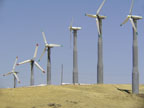The gist: Fossil fuels are dirty and dangerous. And when we present the choice—in clear, concrete terms—between the real benefits of clean, renewable energy, produced here at home, and the dangers of dirty fuels, it’s really a “no-brainer.”
Recent messaging research by the Natural Resources Defense Fund identifies effective ways to talk about our energy choices. This month’s Flashcard distills the NRDC research for Sightline’s circle of communications colleagues.
The Flashcard:
Talking Dirty Fuels—It’s a “no-brainer”Effective messages contrast the benefits of clean energy with the dangers of dirty fuels, casting solutions as “no-brainers”: Who would move backward when we can go FORWARD? Why spend our next energy dollar on the dirty fuels of the 19th century when we can create good, local jobs by investing in the clean, renewable energy technologies of this century? Who wants dependence when we can be SELF-SUFFICIENT? We’re not going to end our addiction to dirty fuels overnight, but we can become self-sufficient by producing clean, homegrown energy from sources that will never run out, like the sun and the wind. Who would choose dirty energy when we can go CLEAN? Blasting mountaintops; toxic tar sands; drilling even deeper for oil; polluting our air, water, and our bodies. We don’t have to continue down that path. We can choose an energy strategy that phases in clean energy sources while phasing out dirty fuels. |
Top NRDC Research Findings:
- A main goal for US energy policy is “self-sufficiency,” which means more in the public’s mind than just independence from foreign oil.
- There is great public enthusiasm for clean, safe renewable energy that will never run out.
- Without strong communications about their dangers, the public is open to new methods of dirty fuel extraction, including oil shale, tar sands, and liquid coal.
- Messages that focus on the potential benefits of clean energy while highlighting the harm of dirty fuels (in vivid, concrete terms) are most effective.
Seven NRDC Tips for Effective Messages About Clean, Safe, Renewable Energy:
- Use language that stays close to experience and far from abstraction.
Describe both the dangers of dirty fuels and the benefits of clean energy in vivid, visual, concrete terms. Connect concepts to our bodies, our health, and our everyday experience. For example, use “the air we breathe and the water we drink” rather than “the environment.” Mention specific chemicals that already have toxic associations (e.g. arsenic or cancer-causing chemicals). Instead of saying “conservation,” say “making the most of the energy we already use.” - Explain the word “renewables” with everyday language.
Instead of just saying “renewables,” explain what clean energy really is in language everyone can understand. For example, renewables are “sources of energy that will never run out, like the wind and the sun,” “the geothermal energy at the hot core of the earth,” “homegrown energy,” or “efficient biofuels made from everything from algae to ivy.” - Use an effective emotional structure that resonates with the public.
Effective messages begin with aspirational language (generating hope or pride), then raise concerns (generating worry, anger, or motivation to act), and end with aspirational language (back to hope or pride, for example). - Label new technologies for extracting dirty fuels for what they are: increasingly dangerous and dirty ways to mine the fuels of the past.
Always draw a distinction between dirty vs. clean, safe, renewable sources of energy. Who would choose dirty old fuel sources and increasingly dangerous methods of extraction when we can go clean? The addiction metaphor is useful in this context: “The solution to our addiction to foreign oil is to end our addiction by phasing in clean, renewable sources of energy that will never run out and that create a new manufacturing base here at home, not to search for higher-risk, more expensive, more destructive ways of getting a fix.” - Tone down the attack.
Messages that go on the attack too relentlessly, too long, or too early draw weaker positive responses from the public. Sandwich attacks in less negative language by offering hopeful solutions. - And when attacking, use specific examples.
Making the threats of dirty fuels concrete and visual (arsenic and mercury in our drinking water) is extremely powerful and moves people to greater levels of support for clean energy issues—but the threats should never come before a hopeful statement about what we could do instead. - Use clear, visual language and link it to job creation when talking conservation.
Messages such as “refitting our homes with appliances that save energy” are perceived as believable and it’s important to link conservation messages to job creation. For example, “retooling the American auto industry to stop making gas guzzlers and create the efficient cars—and local manufacturing jobs—for this century.”
Click here for NRDC’s research fact sheet and more sample language.
Methodology:
Recommendations are based on messaging research conducted for NRDC by Belden, Russonello, and Stewart Research and Communications and Westen Strategies, LLC. Six focus groups were conducted February 8-10, 1010 in Denver, Chicago, and Columbus. A national telephone survey of 1,200 Americans over 18 was conducted March 15-28, 2010. Online dial testing was conducted May 4-10, 2010 with 900 registered voters.









